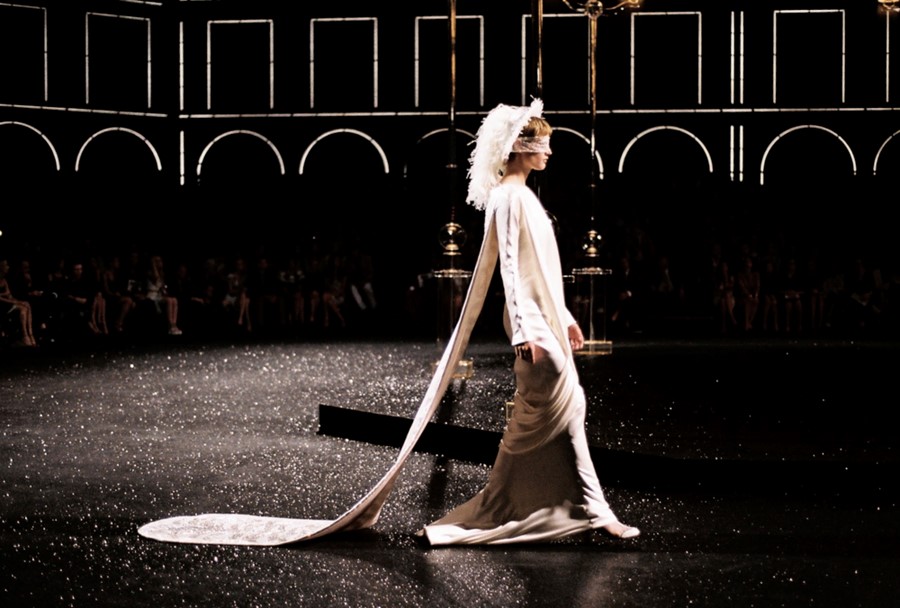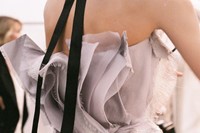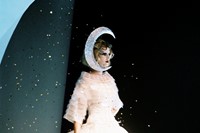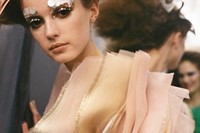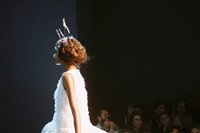Azzedine Alaïa's first show in eight years, a supremely confident collection at Chanel, white looks at Givenchy, Peugeot seatbelts as braces at Margiela and glamourous full-length gowns at Valentino. Just a few highlights from the haute couture
Twice a year the haute couture shows come round, like hot hand towels at the beginning and end of a flight. And just like those steaming serviettes, nobody really knows what to do with them, or what they’re for. But we enjoy the experience and novelty, of pressing their refreshing cleanliness against our grimy faces. Such is pressing one’s plebeian nose against the glass of the most elaborate, most exclusive and most elegant collections in the world.
The normally staid and stately atmosphere of the week was of course rocked by the conspicuous absence of John Galliano, whose regal flourishes and limitless embellishments had become a leitmotif for the creativity and craftsmanship of the couture shows. But Christian Dior’s autumn/winter 2011 offerings were designed by Bill Gaytten, head of the Dior design studio – he has been made creative director of Galliano’s eponymous label, but no-one has yet officially ascended to the role at LVMH’s flagship label. And this much was obvious at the show, which took in Pierrot clowns and a whacky sort of postmodernism with ensembles that were nothing if not exquisitely schizophrenic. Pastel leaves of chiffon framed by brash red and worn with a black and white striped leather skirt; crazy-paving separates and pop art-esque jackets with oversized buttons. There was zaniness in spades, but none of the usual hauteur at a show which normally sets the standard for the week.
Another change to the week came with the arrival of legendary designer Azzedine Alaïa. Having launched his ready-to-wear line in 1983 and presented it via private appointments at his rue du Moussy headquarters, this year he was finally recognised by the Chambre Syndicale and granted a place on the official schedule. Long overdue most would say. In his first show in eight years, the 25-look collection bore the Alaia house codes – sculpted knit silhouettes, animal skins, laser cut leather belts and virtuoso skirt details – in shades of plum, olive, navy, black and white. The succession of floor-length evening gowns were standout.
At Chanel, Karl Lagerfeld also concentrated on the house’s heritage and signatures, translating inspiration from Fritz Lang’s Metropolis within the framework of Coco Chanel’s own biography. And models in sculpted and exaggerated suiting walked around a reconstruction of the Place Vendome with a statue of the founder at its centre. There were digital takes on the usual boucle here, and raffia-style trim to shift dresses, detailing was presented as integral rather than superficial, and made for a supremely confident collection.
Riccardo Tisci too stuck to his guns at Givenchy – after a bright and bold ready-to-wear collection and a menswear show last week that walked a similar path, for couture his pieces were nearly all rendered in white. The dimension play of the mainline collection was referenced in thick layers of pearls that added bulk to sheer sweaters and skirts, and the palette of white and oyster was enhanced by gold accents. Maison Martin Margiela took luxury in a rather different direction, with organza suits held together with masking tape and belted with string. Sports socks were given wedge heels and made into footwear; Peugeot seatbelts became braces. The pun on reclaimed objects sat well at a round of shows that are more about projection than practicality.
There was less opulence at Jean Paul Gaultier but even more sense of a self being established – couture’s enfant terrible turned too to well-trodden mores (for him) in eccentrically cut and pin-tucked pinstripe suits, a New Look-esque skirt suit enhanced by drapery and trim, and long-line Thirties-style trousers worn with cropped, boxy jackets. Gaultier’s muse is without fail an Agent Provocateur, it just depends which century he chooses to root her in – this time, the Weimar overtones worked brilliantly.
This exploration of penultimates was a theme at Valentino courtesy of Maria Grazia Chiuri and Pier Paolo Picciolo, whose moodboard for the collection featured portraits of the deposed Russian Royal family. And the clothes took their inspiration from this era too, not just aesthetically but metaphorically in their fragility and ethereal details. Delicate and frothy chiffon and silk were made simple by being arranged on column dresses in horizontal panels; the most glamourous and sinuous of full-length gowns came in chameleonic nude, with an equally phantom-esque jacket. These were ghosts of clothes, imbued with nostalgia and the sense of a world gone with the wind.
Which is, perhaps, what couture week has come to be representative of. But that’s not to say we the people shouldn’t enjoy it when it comes around. After all, a plane journey isn’t a plane journey without the hot towels.
Text by Harriet Walker
